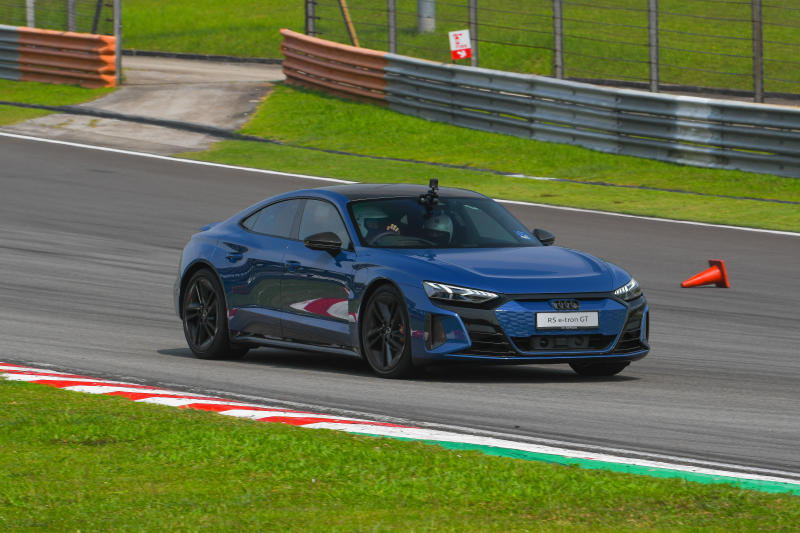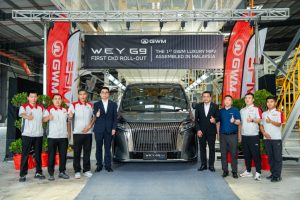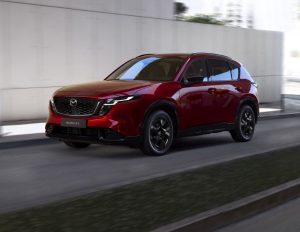AUDI’S return to the Malaysian market through PHS Automotive Malaysia has seen some interesting cars being introduced to re-establish a firm footing, not least of which are the seven electric e-tron models in mid-June.
Carrying the boast of the largest fleet premiere of all-new fully-electric vehicles, it reflected Audi’s determination to flow with the new automotive power trend that is slowly but surely taking root here.
Yes, for now, one has to live with long charging times and fewer charging stations compared to quick top-up and ubiquitous petrol stations for non-electric vehicles, but one couldn’t deny the sporty driving fun that the Audi e-tron range offers.

Electric vehicles are heavier compared to non-electric cars due to the huge and heavy batteries but that is not stopping carmakers from making their respective EV line-up fun to drive.
We learnt that firsthand with the Audi RS e-tron GT, the flagship of the seven-vehicle all-electric fleet, at the Sepang International Circuit (SIC) recently.

It might be only our second driving experience with electric cars at the SIC – and we don’t think it would be our last – but the RS e-tron GT was the first we drove at a gung-ho pace.
Before we get to the exciting dynamic experience, let’s fill you in on what the RS e-tron GT is all about.

In Audi speak, RS reflects the sportier model replete with all the ‘works’ that usually tops the model range with a hefty price to match.
For the four-door RS e-tron GT, you would be looking at about RM794,000 to above RM808,000 (with Audi Assurance Package) on the road without insurance.

It has a 93kWh battery with a 495km range and there is an electric motor front and rear with differing output to drive the respective wheel axle; combined output is rated at 598PS (646PS in Boost mode) and 830Nm in Boost mode.
Power goes to all four wheels via a two-speed automatic transmission and an electric all-wheel drive quattro system.

The RS e-tron GT is said to accelerate from 0 to 100kph in 3.6 seconds and you shave off 0.3 seconds with the use of Launch Control (Boost mode), which is exclusive to this model.
For a sporty fully-electric car that tips the scales above two tonnes, the breathtaking acceleration easily puts it among the non-electric and lighter supercars.

As we took off in the RS e-tron GT for several laps around the 2.6km south track of the SIC, our drive recollection of the Audi R8 plus in Ingolstadt six to seven years ago came rolling back.
With more than 800Nm of torque driving all four wheels, there was no lack of pace for a ‘heavyweight’ and we could imagine being in the much lighter two-door R8 plus.

Feeling our way through the circuit on the first lap, the RS e-tron GT felt right at home taking to the respective corners at fair speeds.
We decided to push the RS e-tron GT a bit quicker on subsequent laps and like all sports cars, they have limits too.

We went off the track at Turn Nine, a sharp turn that winds uphill, as we charged in too fast and all the hard braking we did wasn’t enough to slow the RS e-tron GT down for us to take the corner cleanly.
Thankfully, it was a dry day and the grass wasn’t wet allowing us to regain control quickly and return to the track, none the worse for the slightly bumpy off-road ‘excursion’.

Reducing the corner entry speed from 160kph to 150kph appeared to help as we could slow the car enough with hard braking to take Turn Nine cleanly with the help of the cone markers laid out as guides.
Generally, the RS e-tron GT could cut it as an all-electric sports car despite its heavyweight status.

It might not be quite as nimble as the more compact and lighter R8 plus but you could still enjoy sporty driving fun with the RS e-tron GT.
The RS e-tron GT suspension system sees a double-wishbone front and multi-link rear, and the tyres fitted were 265/35 R21 front and 305/30 R21 rear; both are Goodyear Eagle F1 tyres designed specifically for EVs.

As for standing acceleration, the RS e-tron GT is just as quick off the line as the R8 plus (540PS and 540Nm) and that is admirable given its additional body weight, albeit with a lot higher torque output.
We did two 0-100kph acceleration runs on Launch Control, using the car’s timing system.

For Launch Control, it is a matter of using the left foot to step on the brake pedal and the right foot to floor the accelerator pedal.
You then take your right foot off the accelerator pedal and away you go; we clocked 3.0 seconds on the first run and 3.1 for the second.

That’s under Audi’s claim of 3.3 seconds but there are variables like track surface and tyre condition, among others, that could affect acceleration times.
If you have the money to burn, the RS e-tron GT is right up your alley; it has spirited looks, a comfortable interior with Nappa leather seats, an informative instrument display and the sporty performance and dynamics to whet your cravings.

The cheaper alternative is the e-tron GT quattro, which we didn’t drive as we felt it would be less exciting with lower output of 476PS (530PS in Boost mode) and 630Nm (640Nm in Boost mode) but no Launch Control.
This variant is priced just under RM590,000 on the road without insurance and RM600,790 with Audi Assurance Package.
















